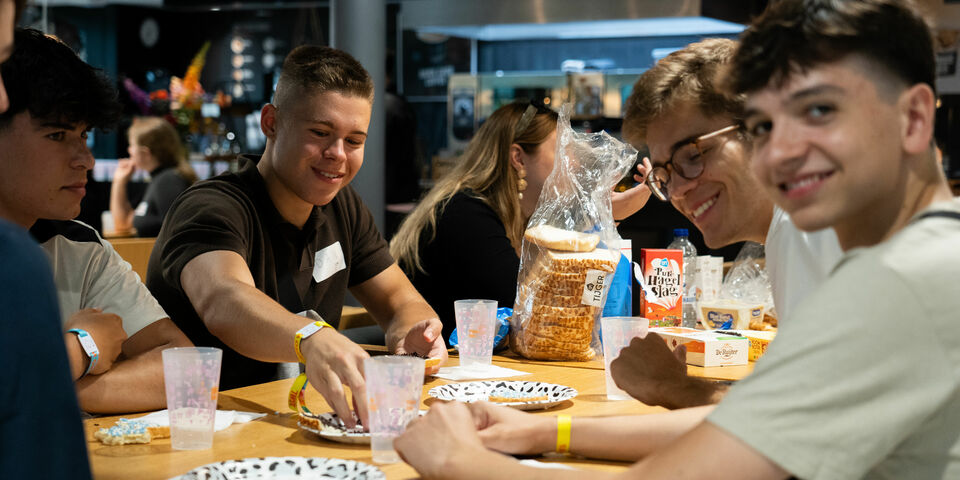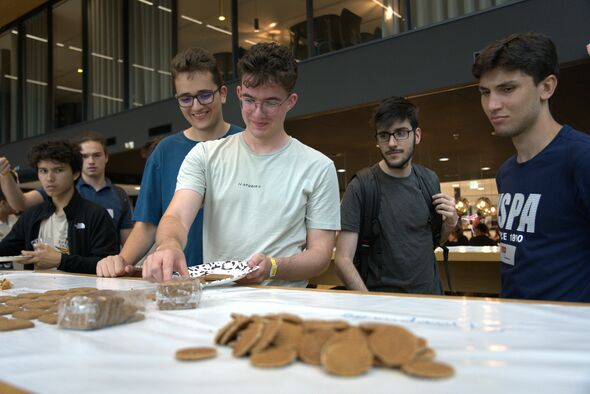International students try typical Dutch food
During last Friday's Welcome Day, international students got their first taste of Dutch cuisine. “We’re very aware of the fact that our cuisine is not considered to be first-rate,” says organizer Lara Hofstra (ESA) to a group of eighty first-year students. They seem to agree.
The tables at Brownies and Downies are full of international students eager to taste what Dutch cuisine has to offer. A dozen or so students have to wait or the next round. “The plan was to have two groups of 40 people, but ultimately, there were 45 in the first round and almost 80 in the second,” says Hofstra. “It’s a good thing I stocked up on extra food.”
“This is a culinary experience,” Hofstra begins. On their plates, the students find rusks with pink and blue aniseed comfits (“muisjes”) and bread with chocolate sprinkles (“hagelslag”). She has the students repeat the word “hagelslag”. The hard “G” proves tricky for them. “This is a typical Dutch breakfast,” Hofstra tells the students. Sounds of disbelief can be heard throughout room. Students look at each other like they can’t believe what they’re seeing. “It is what it is.”
As soon as the students try the rusks, they immediately wash it down with the much-appreciated large glass of water that was provided. “It’s a bit dry,” says one student when asked about his experience.
See more below the picture.
Koekhappen
Next up are sugary treats. “Who here is familiar with koekhappen?” Hofstra asks. The students remain silent. She explains how this is a common activity at children’s parties. “A piece of rather dry spiced cake is hung from a string. With their hands behind their backs, the children then try to eat it.”
The students don’t have to go that far; they are served one on a plate. In addition to spiced cake, they also get to try mini stroopwafels, speculaas biscuits and sugar bread. The story of Sinterklaas is explained. The students are introduced to the typical pepernoten, which are scattered around and picked up by kids. In December, but usually much earlier, pepernoten can be found in stores everywhere.
Licorice
In round three, the students are served rye bread, licorice (both sweet and salty), and a skewer with pickle, cheese and a grape. “If you’re ever invited to a birthday party here in the Netherlands, this is what you can expect,” says Hofstra, referring to the skewer. “You all sit in a large circle and you’re never invited around dinner time because they don’t want to cook for you.” Bitterballen are mentioned too. “A Dutch delicacy.” A few students nod in agreement, already familiar with the savory snack. Unfortunately, the licorice is less well-received. Reactions range from “it tastes like medicine” and “it’s not terrible” to “a unique taste”.
Finally, students are asked to describe Dutch food in one sentence. “Food devoid of any joy,” one group responds. “Baby food you wouldn’t even give to a baby,” other students shout.
Teary eyes
“It was a fun experience,” first-year student Camila (Chemical Engineering) responds afterwards. “Although the food could have been better.” Ellie, who is enrolled in the same program, adds: “This tasting has made us appreciate Greek cuisine even more.” Polish Architecture, Urbanism and Building Sciences student Aleksandra thought the licorice was awful. “It even brought tears to my eyes; but the stroopwafels made up for it.” Bulgarian student July (Architecture, Urbanism and Building Sciences) didn’t mind the licorice as much, but enjoyed the skewer with pickle, cheese and a grape more.
Because of the tight budget, there was no room for “real” Dutch evening meals. “There was herring on the menu as well, but there was no more time to prepare it,” Hofstra said. “Next year we will do this again, but spread out over several days. Otherwise it's way too busy.”





Discussion